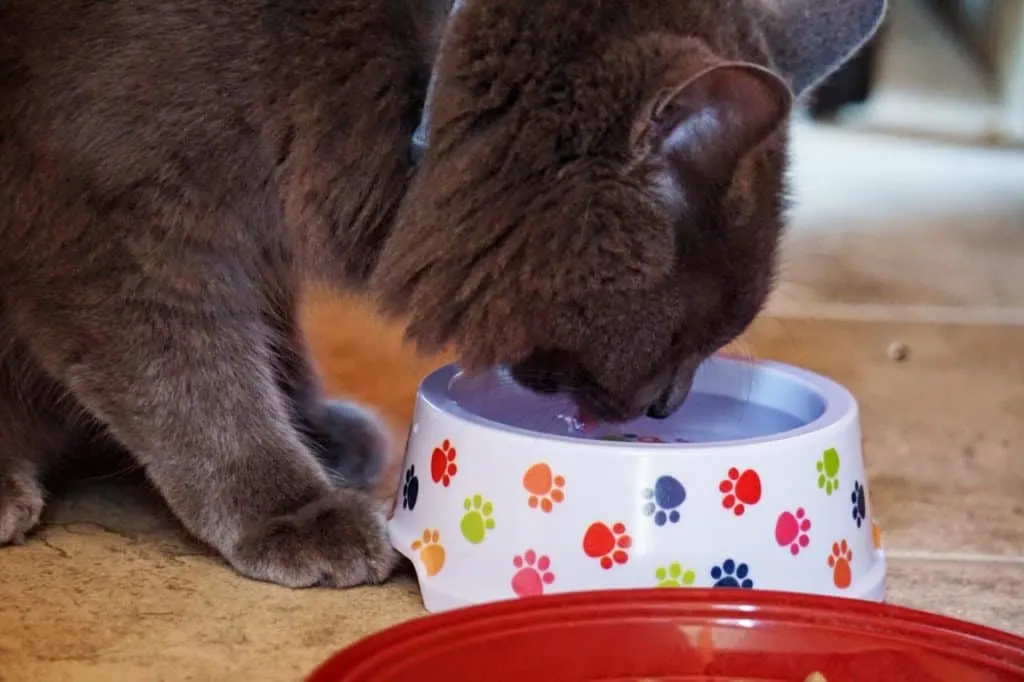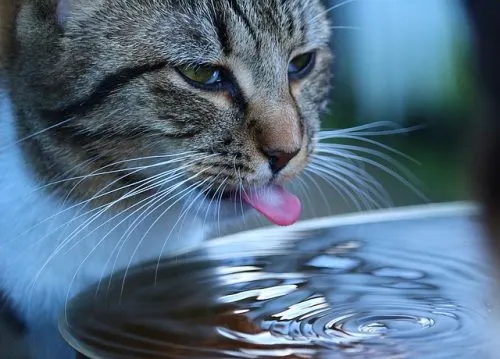We are always told how staying hydrated is important for our own health, but did you know that it’s also vital to your cat’s health? And do you know how to check if your cat is dehydrated?
Current estimates predict that 1 in 3 cats (or more) will develop some form of kidney disease in their lifetime. This is why keeping on top of your cat’s hydration levels is super important.
But how do you know if your cat is dehydrated? And what steps can we take to increase a cat’s water intake? This article is here to help, with a full introduction to cat dehydration signs, symptoms & treatment. As well as top ticks and tricks to stay on top of your cat’s hydration day to day.
Key Takeaways:
- Wild cats were used to conserving water, and getting much of their fluid intake from prey — which could contribute to domestic cats’ reluctance to drink from a bowl.
- There aren’t a heap of studies on domestic cats and drinking water, but typical recommendations are that a cat requires about 50ml of water per kg of body weight daily.
- Check your cat is dehydrated by pulling gently at their skin, if it snaps back they are hydrated, if not they could be suffering from dehydration.
- Cats seem to like smaller bowls, in several locations around the house.
- Transitioning to a wet or partly wet diet can help your cat get more hydration daily.
How to Check if Your Cat Is Dehydrated

Why Do Cat’s Get Dehydrated?
Our domestic fur-friends’ ancestors were highly adaptable to drought conditions. Living in desert areas, they developed the ability to concentrate their urine and take reduced water intake in their stride.
But it’s these skills that can affect our domestic kitty’s negatively, as they live both much longer and very different lives to their wild cousins. Many believe that these abilities have negative effects over long periods of time, as some domestic cats can now live to 20 years!
It’s also important to think about the natural food of cats – small prey such as rodents, mammals, and birds. This diet has been found to contain around 70% moisture, compared with a modern diet of dry kibble that often contains less than 10% moisture.
So we can see how our furballs often do not have a naturally strong urge to drink water like other pets might, even when their bodies need it. And modern-day diets may be reducing their moisture intake on top of that too.
Dehydration is especially common when other existing factors are affecting your kitty too, such as:
How Much Water Does My Cat Need?
General guidelines for cats are that they should have around 50ml of water per kg of body weight per day. That’s around 150 to 200ml a day for an average-sized cat.
How to Check if Your Cat Is Dehydrated
So how do you know your cat is dehydrated? What are the signs and symptoms of dehydration in cats?
Knowing how to check if your kitty is dehydrated is super important for their long term wellbeing, so let’s look at some common cat dehydration symptoms:
- Loss of energy — Is your cat looking more lethargic than usual? Do they seem less playful or engaged recently?
- Lack of appetite — Is your cat leaving leftovers or seeming uninterested in mealtimes?
- Constipation — Is your cat’s litterbox looking bare? Or are they producing hard-looking pellets?
- Panting — Do they seem overly hot and exhausted?
- Hiding or nervous behavior — Are they uncharacteristically quiet or frightened?
There are a few cat dehydration tests you can perform to confirm your suspicions that your cat is suffering from dehydration too:
- Examine the eyes — Dehydrated cats often have eyes that look sunken, dull, or lack their normal focus.
- Examine the gums — Tacky and dry gums are common signs of lack of moisture.
- Examine the skin — Gently take a small portion of your cat’s skin and lift it up. When you let go, the skin will quickly snap back into place if your cat is well hydrated. If the skin falls back down slowly your cat could be dehydrated.
If you are doing the skin test and you see that your cat’s skin remains up, in a tent-like position, and does not fall back down this is a sign of severe dehydration.
If this is the case, try and visit your veterinarian as soon as you can to get your cat some help.
How to Hydrate a Dehydrated Cat
If you think your cat is dehydrated, it’s a good idea to book an appointment to discuss this with your veterinarian. Cat dehydration treatment at home is a great option to quickly help your cat, but a vet will be able to assess your cat’s hydration levels accurately and aid with ongoing or emergency treatment if needed.
If the dehydration is serious, your veterinarian can perform a quick procedure that involves giving your kitty fluids under the skin.
In very severe cases, your kitty may need to be hospitalized so that they can be rehydrated via a drip and monitored.
Your veterinarian may also want to evaluate your cat to see if they can diagnose any underlying health reasons for your cat’s dehydration, as well as offering strategies for upping their fluid intake.

But before you can make it to the vet, let’s look at what to give a cat that is dehydrated and how much fluid to give a dehydrated cat:
- Add half a cup of water to their next meal, gradually increasing this to a full cup with every meal.
- If they are a fussy eater, try adding a small amount of cat-friendly chicken broth or tuna water (unsalted) to their water.
- Offer several types of water bowls around the house and refresh the water a few times a day.
- Place some ice cubes in their water bowl or on a towel for them to investigate (while supervised.)
It’s important to offer your cat water gradually if it is dehydrated.
If your kitty is dehydrated and then ingests a lot of water all at once it could make them feel even worse. They could even vomit, lose more fluid, and experience intestinal issues as a result.
So slow and steady is the best way to rehydrate your cat.
Until you can see your vet, they may suggest purchasing some cat-friendly electrolytes to restore the balance in their body.
We often get asked — does cat milk hydrate a cat? If your cat is fussy with water, milk can often be a more appealing option. Opt for lactose-reduced cow’s milk, as this contains a good amount of water whilst having less of the tummy-upsetting effects of full-fat milk.
How to Increase Cat Water Intake
As with much of our furball’s wellbeing, prevention is the best cure! So let’s look at some ideas for how to increase cat water intake:
1. Choosing the Right Bowl
A study by Royal Canin found that small bowls (<15 cm in diameter) were preferred to larger bowls, and were more popular than fountains for the cats in the study.
However — each cat is an individual so test out different methods to see which encourages your cat to drink the most.
Providing more than one watering point is also thought to help encourage cats to drink up, ensuring these are away from their litter tray and feeding area.
For some kitties, getting an automatic water fountain can really help cats drink more water as the flowing water entices them.
2. What Is the Best Water for Cats to Drink?
Some say cats prefer mineral water, others say rainwater, and some owners swear by mineral water.
No studies have found a conclusive answer to this, so experimentation is your friend!
Try putting out several bowls of different types of water and see which one your cat seems to gravitate to.
Whichever they like, be sure to change out the water frequently, as freshwater will always be more appealing to your kitty.
3. Adding Moisture to Your Cat’s Food
Now that we know our cats need around 50ml of water per kg of body weight, you can work out how to help them achieve this through their food.
Using the moisture content of their food, try adding additional water to help them hit 80 — 90% of their water target for the day through their meals.
This may be harder to do with a predominantly dry food diet, so it may help to transition to either a partially wet or fully wet diet for your cat.
Is wet food enough water for cats? Not always.
It’s still worth looking at the moisture content of your wet food and working out if your cat needs a little extra moisture.
Adding water, broth or tuna juice (make sure they are cat-friendly) to this can be a great way to keep your cat super hydrated and healthy.
As for how to keep wet cat food moist? Seal in air-tight containers between uses and refresh with the options above with each meal.
What Is the Best Wet Food for Dehydrated Cats?
If you are looking to transition your cat onto a higher moisture diet, or want to prevent dehydration in the future, here are some wet food brands we love:
ZIWI Peak Provenance Canned Wet Cat Food
Designed to match closely to a cat’s natural, whole-prey diet, this canned food features 97% real meat, organs, seafood, superfoods, and bone broth. Formed into a pâté-style, moisture-rich, chunky-loaf – it’s getting rave reviews for its palatability. Plus ZIWI source from 100% free-range, grass-fed meats, cage-free poultry, and wild-caught seafood, sourced from New Zealand – so it’s got a double thumbs up from us!
Tiki Cat Aloha Friends Grain & Potato Free Canned Wet Food
Made with high-quality ingredients, this canned wet food comes in a savory, high-moisture broth to give your cat that little extra boost of hydration in their meals in a palatable way. With added pumpkin for a gentle source of fiber, the carbohydrate count is still very low to allow for full moisture absorption.
Purina ONE Urinary Tract Health Beef & Liver Recipe wet cat food
This moisture-rich recipe is made from 100% beef, with no added fillers, flavorings, or grains. This can help to naturally boost the moisture absorbed, whilst the addition of antioxidants helps to boost health whilst lowering urinary PH. This can help to reduce the chances of urinary damage and dehydration.
If your cat suffers from frequent UTIs, check out our guide to The Best Cat Foods to Support UTI Health in Cats.
Broths & toppers can also be a great way to add moisture to your dry kibble, especially for fussy eaters:
Nulo FreeStyle Bone Broth for Dogs & Cats
With an extra boost of protein and packed with superfoods, these bone broths are a great savory addition to your kitty’s meals. A natural source of collagen and chondroitin sulfate to help support their coat, skin, and joint health with 100% human-grade ingredients.
A slow-simmered bone broth that’s packed with those healthy collagen proteins and amino acids to support your kitty’s gut health. Designed as a tasty hydration boost, Solid Gold guarantees a rich flavor and a textural sensation that your cat will delight in.
Final Thoughts
Have you learned anything about how to improve your cat’s hydration? We certainly did in writing this post!
It has inspired us to take a more active approach and help Yoda get those extra sips of water a day, both through his food and through multiple small bowls of fresh water around the house.
It’s also important to be able to spot those early signs of possible dehydration, to avoid any hospitalization.
What will you add to your kitty’s routine to help their hydration? Let us know! 🙂
